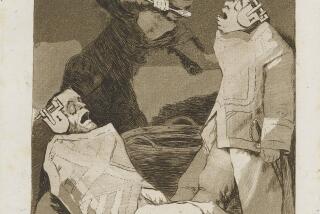SURPRISES UNFOLD IN PAPER ART
Vera Viana Asper was first drawn to the art of paper-making because of its mystery.
“You never know exactly how the paper is going to turn out. There are always surprises,” said Asper, 60, whose paper compositions will be on display through June 29 at the Bowers Museum Galleria in Santa Ana.
The Costa Mesa artist primarily uses a technique called “vacuuming” to work thick sheets of paper into abstract forms. She starts by taking everyday objects--often discards found in backyards, trash cans or dumps--and aligns them in patterns under the wet paper. That’s when the “vacuum machine” is used to literally suck the sheets down around the objects, with the paper eventually assuming their shapes.
“You can do the same thing the vacuum does by hand, but that takes a long time. The machine accomplishes the same thing in minutes,” she said.
Asper then adds other paper strips or patches and paints the surface with watercolors, acrylics or oils. She often uses bold hues--a style she said was inspired by Vincent van Gogh’s dramatic use of color.
“Experimenting with color is always interesting, but getting the form I want is the biggest challenge,” said Asper, a member of a five-artist cooperative that runs the Papermaking Center in Costa Mesa. “The paper fibers have their own will and often take shapes of their own, completely different than what I had in mind. But I like that; it creates spontaneity.”
She also likes “the organic quality” of her art. For Asper, reams of paper inspire visions of giant redwoods as well as images of rose petals, blueberries, straw, onion skins and broccoli.
Asper makes much of her own paper from fibrous vegetables, flowers and grasses. First she boils, say blueberries, over the stove and then mashes the pulp into flat, thin sheets of paste. She might add dye if the natural color is not appealing and a bonding compound to ensure the paper does not fall apart. The last step is a day’s drying in the sun.
“What I don’t eat, I may use for my paper,” Asper said, laughing. “It’s a utilitarian approach that is also very practical.” The many different fibers she uses produce a variety of textures, making each composition unique, she said.
Her utilitarian approach also is reflected in the objects she uses to form abstract shapes--everything from bits of old Styrofoam to wood logs found in the dump.
Among the 15 compositions on display at the galleria is a series that underscores her reliance on throwaways or other mundane items most people take for granted. Seven of the pieces were made from a “pet door,” the small hatch installed in some homes to give animals easy access to the backyard. Asper, who painted and treated some of the finished compositions so they would resemble stone, bronze and leather, chose the pet door for its familiarity to many domestic animal lovers and its “general silliness.”
“I had this door in my own house and looked at it for several years, thinking it was ugly and one of the silliest things I’d ever seen,” she said. “It seemed like a funny thing to do; that is, making an entire series out of such a low object. It sort of pokes fun at art in a way.”
Humor, often satiric, is a frequent theme in her work. Asper said she never wants to be accused of taking her art too seriously.
“There’s always all this talk about what this means and what that means, and it all gets so philosophical and profound,” Asper lamented. “More art should have a sense of humor about itself. Art, after all, can entertain as well as enlighten.”
She does not, however, take the art of papermaking lightly. Beside helping run the Papermaking Center for other paper artists, Asper regularly gives lectures on papermaking techniques at local schools and colleges.
“You might say I’m spreading the word,” she said.
The Bowers Museum Galleria, located next to the museum at 2036 N. Main St. in Santa Ana, is open Wednesday through Saturday, 11 a.m. to 4 p.m.; Sunday, noon to 4 p.m.
More to Read
The biggest entertainment stories
Get our big stories about Hollywood, film, television, music, arts, culture and more right in your inbox as soon as they publish.
You may occasionally receive promotional content from the Los Angeles Times.










